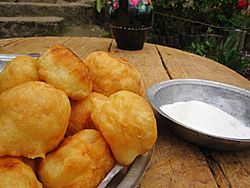Zalabiyeh facts for kids

Deep-fried zalabiyeh
|
|
| Alternative names | Spongy dough (sufgan), zlebia, jalebie, zülbiya, jilapi |
|---|---|
| Type | Fritter, Doughnut |
| Region or state | Europe, West Asia, Yemen, Ethiopia North Africa, Egypt |
| Main ingredients | Batter (flour, yeast, water, salt), Optional: eggs, milk, sesame oil, sesame seeds |
Zalabiyeh (pronounced Za-LAH-bee-yah) is a yummy fried pastry, kind of like a fritter or doughnut. You can find it in many countries across Europe, the Middle East, and West Asia. It's made from a thin dough mix, called batter, usually from wheat flour. This batter is carefully poured into hot oil and deep-fried until it's golden and crispy.
The very first known recipe for Zalabiyeh is super old! It comes from an Arabic cookbook written way back in the 900s. Back then, people even used a coconut shell to pour the batter! For Mizrahi Jews, Zalabiyeh is a special fried dough, often covered in sweet honey or syrup. In the Ladino language, it's sometimes called burmuelos.
Contents
The History of Zalabiyeh
The oldest recipes for zalabiya come from a 10th-century Arabic cookbook called Kitab al-Tabikh. This old book shows how people made these tasty treats a long time ago. In some old Arab recipes, the dough was even poured through a coconut shell!
This type of fried pastry is similar to the jelabi from India. It's also like a 16th-century German pastry called strauben, which was made using a funnel. Over time, people developed different ways to make this sweet dessert.
How Zalabiyeh Changed Over Time
In the 10th century, a writer named Muqadassi described how people in Greater Syria made Zalabiya in winter. They made a deep-fried bread fritter. Some were long, like crullers, and smaller ones were shaped like dumplings or balls.
In North Africa, the name Zalabiya was used for a different pastry. This one was called Mushabbak. It was a deep-fried, lattice-shaped pastry made by looping batter. After frying, it was soaked in sweet honey syrup.
In 1280, a Jewish-Sicilian doctor named Faraj ben Salim translated an important book. This book included several Persian recipes, and one of them was for "Zelebia." This shows how far and wide the recipe traveled!
Zalabiyeh in Yemen
Among Yemenite Jews, zalabiyeh was a special treat, especially during the cold winter months. In Yemen, it was fried in a soapstone pot with about 1 centimeter of oil. Sometimes, honey was mixed into the oil for extra flavor.
The zalabiyeh in Yemen was made from a soft yeast bread dough. It was fried on both sides until golden. Some people added black cumin to the dough to make it taste even better. People ate them while they were still hot, often with honey or sugar.
Special Occasions and Customs
Zalabiyeh is a popular food for many different celebrations.
- Muslims often eat Zalabiyeh during the holy month of Ramadan.
- Hindus and Indian Christian communities enjoy them during Diwali celebrations.
- Sephardic Jews eat them for Hanukkah, a festival of lights.
In Lebanon, people eat Zalabiyeh on the night of January 5th. This celebrates the baptism of Jesus Christ. The dough is mixed with aniseed, which gives it a unique flavor. In the southern part of Lebanon, they even make three holes in the dough. These holes symbolize the Holy Trinity. On this day, people eat both the long and round versions of Zalabiyeh.
For Persian Jews, Zalabiyeh (or zelebi) is a traditional sufgan, which means "spongy dough."
Modern Types of Zalabiyeh
This fried pastry is very common in the Indian subcontinent. You can find it in countries like India, Pakistan, Sri Lanka, Nepal, and Bangladesh. However, the way it's made there is a bit different from the Middle Eastern and North African versions.
In many Middle Eastern and North African countries, Zalabiyeh looks like spongy cakes fried in oil. These countries include Iran, Iraq, Jordan, Syria, Lebanon, Tunisia, Algeria, Ethiopia, and Egypt.
Zalabiyeh Around the World
- In Iran, it's called zolbiya. It was traditionally given to people in need during Ramadan. There are old recipes from the 13th century for this sweet treat.
- In Iraq in the 20th century, starch was a main ingredient in their zalabiyeh. It was often topped with sugar.
- In North Africa, zalabiyeh was often made by adding yogurt to the dry ingredients.
- It's known as zlebia in Tunisian cuisine.
- In the Philippines, it's called jalebie.
- It's zülbiya in Azerbaijan.
- In Nepal, it's called gwaramari.
- And in India, it's known as jilapi.

